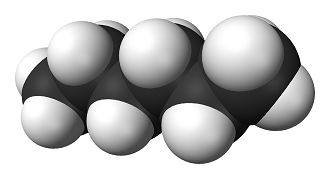Hexane: Difference between revisions
J.williams (talk | contribs) No edit summary |
m 1 revision imported |
||
| (6 intermediate revisions by 4 users not shown) | |||
| Line 1: | Line 1: | ||
[[Category:Done | [[Category:Done 2020-01-31]] | ||
[[Category: Translated to French]] | |||
[[File:hexane.png|200px|framed|right|Figure 1. Space-filling model of hexane, the white spheres represent [[hydrogen]] atoms and the black spheres represent [[carbon]] atoms.<ref>"Hexane-3D-vdW.png" Licensed under Public Domain via Wikimedia Commons - http://commons.wikimedia.org/wiki/File:Hexane-3D-vdW.png</ref>]] | |||
[[ | <!--T:2--> | ||
<onlyinclude>'''Hexane''' is an [[alkane]] with the chemical formula C<sub>6</sub>H<sub>14</sub>. As a [[hydrocarbon]], it can undergo [[hydrocarbon combustion]] which gives off [[heat]].</onlyinclude> Traces of hexane can be found in raw [[natural gas]], which is a type of [[fossil fuel]].<ref>“NATURAL GAS FAQs,” Pacific Northern Gas RSS. [Online]. Available: http://www.png.ca/natural-gas-faqs/. [Accessed: 24-May-2017]</ref> This hexane is usually removed before being shipped to customers as an [[energy currency]]. | |||
Hexane has several important uses. Hexane is used frequently in the production and extraction of edible oils from nut and vegetable crops, such as soybeans and peanuts | <!--T:3--> | ||
Hexane is a [[volatile]], colourless [[liquid]] that is highly [[flammable]] and insoluble in [[water]].<ref name=usepa> United States Environmental Protection Agency. (November 18, 2013). ''Hexane'' [Online]. Available: https://www.epa.gov/sites/production/files/2016-09/documents/hexane.pdf [May 28, 2017]. </ref> Hexane has several important uses. Hexane is used frequently in the production and extraction of edible oils from nut and vegetable crops, such as soybeans and peanuts.<ref name=usepa /> | |||
<!--T:4--> | |||
This [[organic molecule]] also has several industrial uses. Primarily, when used in commercial grades, hexane is used as a solvent for glues and varnishes where water cannot be used. This works because hexane is a [[non-polar solvent]] while water is a [[polar solvent]]. It is also used as a cleaning agent known as a ''degreaser'' in the printing industry.<ref name=usepa/> | |||
==Properties== | ==Properties== <!--T:5--> | ||
Below is a table of some of the basic properties of hexane. | Below is a table of some of the basic properties of hexane. | ||
<!--T:6--> | |||
{| class="wikitable" | {| class="wikitable" | ||
|- | |- | ||
| Line 20: | Line 22: | ||
| [[Molar mass]] || 86.17 [[kilogram|gram]]s/[[mole]] | | [[Molar mass]] || 86.17 [[kilogram|gram]]s/[[mole]] | ||
|- | |- | ||
| Melting | | [[Melting point]] || -95<sup>o</sup>C<ref name =elmhurst>Charles E. Ophardt. (2003). ''Virtual Chembook - Hydrocarbon Boiling Points'' [Online]. Available: http://www.elmhurst.edu/~chm/vchembook/501hcboilingpts.html [February 16,2015].</ref> | ||
|- | |- | ||
| Boiling | | [[Boiling point]] || 69<sup>o</sup>C<ref name =elmhurst/> | ||
|} | |} | ||
==Combustion Reaction== <!--T:7--> | |||
<!--T:8--> | |||
Hexane also undergoes [[hydrocarbon combustion]], combining with [[oxygen]] to form [[carbon dioxide]]. The balanced chemical equation for the complete combustion of hexane is: | |||
<!--T:9--> | |||
<center>2C<sub>6</sub>H<sub>14</sub> + 19O<sub>2</sub> → 12CO<sub>2</sub> + 14H<sub>2</sub>O + Heat Energy ([[Enthalpy]]) </center> | |||
<!--T:10--> | |||
The [[hydrocarbon combustion]] reaction releases heat [[energy]] and is an example of an [[exothermic reaction]]. The reaction also has a negative [[enthalpy]] change (ΔH) value. | |||
==For Further Reading== | |||
*[[Chemical energy]] | |||
*[[Chemical bond]] | |||
*[[Combustion]] | |||
*[[Primary energy]] | |||
*[[Energy conversion technology]] | |||
*Or explore a [[Special:Random|random page]] | |||
==References== | ==References== | ||
{{reflist}} | {{reflist}} | ||
[[Category:Uploaded]] | [[Category:Uploaded]] | ||
Latest revision as of 00:02, 27 September 2021

Hexane is an alkane with the chemical formula C6H14. As a hydrocarbon, it can undergo hydrocarbon combustion which gives off heat. Traces of hexane can be found in raw natural gas, which is a type of fossil fuel.[2] This hexane is usually removed before being shipped to customers as an energy currency.
Hexane is a volatile, colourless liquid that is highly flammable and insoluble in water.[3] Hexane has several important uses. Hexane is used frequently in the production and extraction of edible oils from nut and vegetable crops, such as soybeans and peanuts.[3]
This organic molecule also has several industrial uses. Primarily, when used in commercial grades, hexane is used as a solvent for glues and varnishes where water cannot be used. This works because hexane is a non-polar solvent while water is a polar solvent. It is also used as a cleaning agent known as a degreaser in the printing industry.[3]
Properties
Below is a table of some of the basic properties of hexane.
| Chemical formula | C6H14 |
| Molar mass | 86.17 grams/mole |
| Melting point | -95oC[4] |
| Boiling point | 69oC[4] |
Combustion Reaction
Hexane also undergoes hydrocarbon combustion, combining with oxygen to form carbon dioxide. The balanced chemical equation for the complete combustion of hexane is:
The hydrocarbon combustion reaction releases heat energy and is an example of an exothermic reaction. The reaction also has a negative enthalpy change (ΔH) value.
For Further Reading
- Chemical energy
- Chemical bond
- Combustion
- Primary energy
- Energy conversion technology
- Or explore a random page
References
- ↑ "Hexane-3D-vdW.png" Licensed under Public Domain via Wikimedia Commons - http://commons.wikimedia.org/wiki/File:Hexane-3D-vdW.png
- ↑ “NATURAL GAS FAQs,” Pacific Northern Gas RSS. [Online]. Available: http://www.png.ca/natural-gas-faqs/. [Accessed: 24-May-2017]
- ↑ 3.0 3.1 3.2 United States Environmental Protection Agency. (November 18, 2013). Hexane [Online]. Available: https://www.epa.gov/sites/production/files/2016-09/documents/hexane.pdf [May 28, 2017].
- ↑ 4.0 4.1 Charles E. Ophardt. (2003). Virtual Chembook - Hydrocarbon Boiling Points [Online]. Available: http://www.elmhurst.edu/~chm/vchembook/501hcboilingpts.html [February 16,2015].

